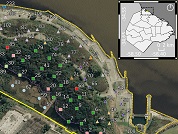Vegetation of a Río de la Plata polderized area in Buenos Aires City: the “Ciudad Universitaria - Costanera Norte” Ecological Reserve
DOI:
https://doi.org/10.14522/darwiniana.2020.82.908Keywords:
Coastal anthropogenic fill, Coastal wetland, Natural protected area, Novel ecosystem, polderizationAbstract
Coastal reclamation constitutes a world trend and can result in new ecosystems adapted to the new coastal configuration. In Buenos Aires City, the “Ciudad Universitaria - Costanera Norte” Ecological Reserve (RECU-CN) constitutes one example of the expansion of the coastline in the Río de la Plata sector, carried out in the late 1960s. Given the lack of published works generated systematically that cover the entire area, we set as the objective to describe the RECU-CN vascular plant vegetation. For this, a systematic sampling was carried out in 79 plots of 25 m2, where the coverage of each of the vascular plant species present was registered. We identified 154 taxa, corresponding to 144 species, 123 genus and 58 families, and the total richness was estimated as 238 species. Trees and herbs had the highest coverage of all life forms. Through multivariate analysis, three vegetation units (Wetland, Forest and Grassland with groves) and 10 vascular plant communities were recognized. Vegetation was ordered according to two gradients: one of flood and another of anthropization. From the comparison with the typical plant communities of the region, similarities were found only with those registered in the Wetland unit. Results highlight that both the coexistence of physiognomically diverse vegetation units, as well as the native composition found in the plant communities of the Wetland unit, constitute main conservation values of the protected area.

Downloads
Published
How to Cite
Issue
Section
License

Starting on 2012, Darwiniana Nueva Serie uses Licencia Creative Commons Atribución-NoComercial 2.5 Argentina .





